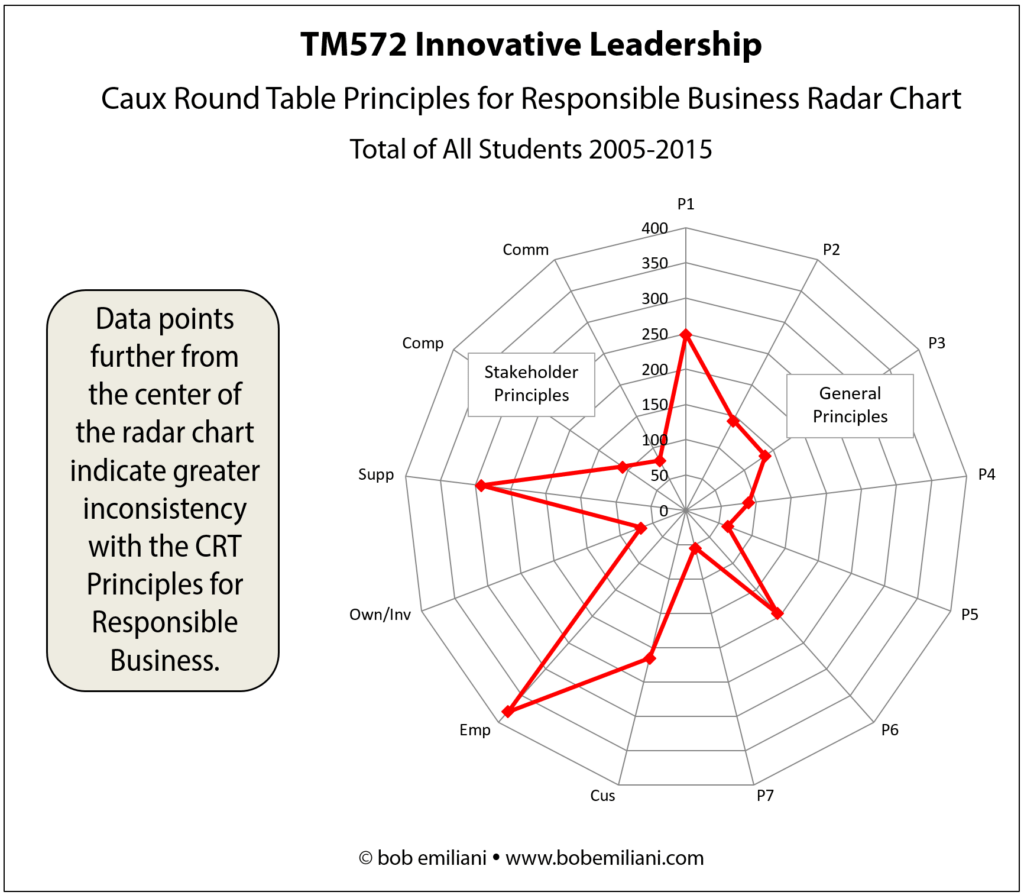For the 23 years that I taught graduate students — working professionals with an average of 15 years of experience in a wide variety of manufacturing and services industries — I always included the “Caux Round Table Principles for Responsible Business” in my Lean leadership course (view the current version of the CRT Principles here). Why did I do that? To help students recognize the larger responsibilities of leaders beyond just shareholders and move people forward from the business as usual tradeoffs between stakeholders to a more balanced perspective — a challenge that is well within the capabilities of talented top leaders.
Sometime in 2003 or 2004, I contacted the head of the Caux Round Table and asked him if he knew of any business schools that were using the CRT Principles as a guiding document for academic programs or for individual courses. To my great surprise, he was not aware of any such use. My use of the CRT Principles appeared to have been unique in higher education. (Read more below).
The CRT Principles came into being in the mid-1980s at the advent of globalization and was formalized as an organization in 1994 (see history here). Interestingly, the CRT Principles closely mirror Toyota’s Sustainability Policy (read here). It is not clear if Toyota’s Sustainability Policy pre- or post-dates the CRT Principles, or if it was developed independently of the CRT Principles.
In the years 2005-2015, I used the CRT Principles as an individual assignment for students to evaluate the gap between the CRT Principles and the company that they worked for based upon their real-world experience — not what their company’s Code of Conduct (or similar document) said. In other words, the actual day-to-day behavior and decision-making of managers that students witnessed at work.
I collected students’ responses over that 10-year period and plotted them on a radar chart. The results are shown in the image below. As you can see, students found large areas of inconsistency with Employees, Suppliers, Customers, Principle 1 (Respect Stakeholders Beyond Shareholders), and Principle 6 (Respect the Environment).

In subsequent years, 2016 through 2022, I used the CRT Principles and the radar chart as an individual reflection assignment. Overall, the assignment gave students perspective on how their company’s managers perform in relation to the CRT Principles and the resulting gaps that they might someday do their part to help close.
The main takeaway is that the radar chart lacks uniformity — many data points located far from the center. This indicates areas of apparent weakness in corporate governance, and thus major opportunities for improvement. Sharp eyes will quickly recognize that the result for Employees, Suppliers, and Customers contradicts the results for Owners/Investors. Can you explain the significance of that contradiction?
A few caveats:
- The radar chart reflects the number of unique responses for the population of students that successfully completed the assignment.
- Students’ responses are based solely on the field of company information that they are exposed to, principally in the workplace, but could include outside sources of information.
- Students were given latitude to use their best judgment to make their assessment of consistency or inconsistency for each category of the CRT Principles in total or sub-principles. Consequently, the design of the assignment does not constitute a rigorous scientific study.
- Times have changed and the results shown in the radar chart could be different.
- Students’ experiences and awareness of inconsistencies between CRT Principles and how managers behave could be greater or less in 2023 compared to previous decades.
- Managers may be more aware of the gaps and have been working to close them.
